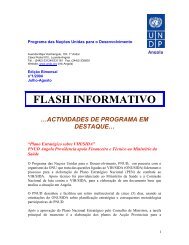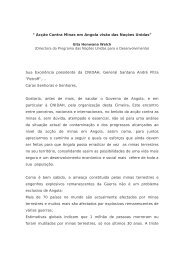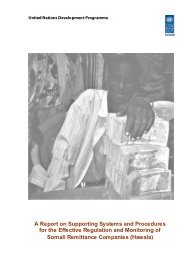CORRUPTION AND ANTI-CORRUPTION STRATEGIES ... - UNDP
CORRUPTION AND ANTI-CORRUPTION STRATEGIES ... - UNDP
CORRUPTION AND ANTI-CORRUPTION STRATEGIES ... - UNDP
You also want an ePaper? Increase the reach of your titles
YUMPU automatically turns print PDFs into web optimized ePapers that Google loves.
not just corrupt individuals, and effective<br />
implementation (Klitgaard, 1997).<br />
For most developing countries, the short-term<br />
goal ought to be finding the means to pursue<br />
the most effective and economical measures to<br />
The Choice of Strategy<br />
Thus there are a number of framework issues<br />
that would need to be addressed when planning<br />
short-term anti-corruption strategies in order<br />
to identify sustainable and cost-effective<br />
measures that have impact. These include<br />
consideration of the following.<br />
Office or Officeholder<br />
Should the focus be on the office or on the<br />
officeholder? Training officials provides them<br />
with transferable skills sought after elsewhere<br />
in the public sector and by the private sector,<br />
particularly in relation to taxation, law and<br />
audit. At the same time, trained officials<br />
working within an inflexible organisation or<br />
unable to effect results become demotivated.<br />
On the other hand, training organisations or<br />
officials in procedures may assist in sustainable<br />
competencies, particularly if new officials are<br />
trained in organisational practices which are<br />
less portable but which may inhibit the initiative<br />
of the officials or imply a lack of faith in their<br />
ability to perform their duties without such a<br />
control environment. Should there also be<br />
'golden handcuffs' – attractive inducements<br />
to retain trained staff – or should there be an<br />
emphasis on performance by sanction where<br />
failure to perform adequately the requirements<br />
of the organisation is the prime criteria – and<br />
how far should organisations be trained in<br />
competency testing and staff appraisals?<br />
Income or Expenditure<br />
The issue here is whether the focus of any<br />
anti-corruption strategy should be on protecting<br />
state revenue – on the integrity and competence<br />
control corruption. How that is arrived at<br />
depends on a number of factors, including the<br />
legacy of previous anti-corruption campaigns,<br />
the reaction of the population to anti-corruption<br />
inquiries and the impartiality of such inquiries<br />
(Findlay and Stewart, 1992).<br />
of the tax and customs agencies and the roles of<br />
Auditor-Generals' offices – or on investigating<br />
evidence of criminal activity such as contract<br />
corruption. The former may assist in the<br />
development of a stable revenue base, while the<br />
latter may more visibly demonstrate the state's<br />
commitment to effective use of resources and<br />
to tackling corruption (investigating and<br />
prosecuting corruption usually means that the<br />
money has been spent or wasted and is often<br />
reliant on the speed and integrity of the<br />
criminal justice system for implementation).<br />
Restitution or Retribution<br />
What is the purpose of the search for public<br />
integrity? Is it retribution – the visible<br />
punishment of wrongdoers – or restitution,<br />
protecting state funds and seeking to return<br />
to the state those funds and related corrupt<br />
payments acquired illegally? While the former<br />
may rely on an effective internal criminal<br />
justice system, the latter would require not<br />
only on effective systems in other countries<br />
but agencies charged with asset tracing,<br />
confiscation and forfeiture.<br />
Vehicle of Reform<br />
Some reformers advocate the establishment of<br />
an anti-corruption agency; others suggest the<br />
development of an approach to more vulnerable<br />
departments or functions. Risk assessment of<br />
departments, procedures and activities that are<br />
most vulnerable to corruption have been done<br />
in a number of states, with the aim of identifying<br />
where corruption may have the most corrosive<br />
impact. This has the end result of targeting<br />
<strong>CORRUPTION</strong>& INTEGRITY IMPROVEMENT INITIATIVES IN DEVELOPING COUNTRIES<br />
5 7







